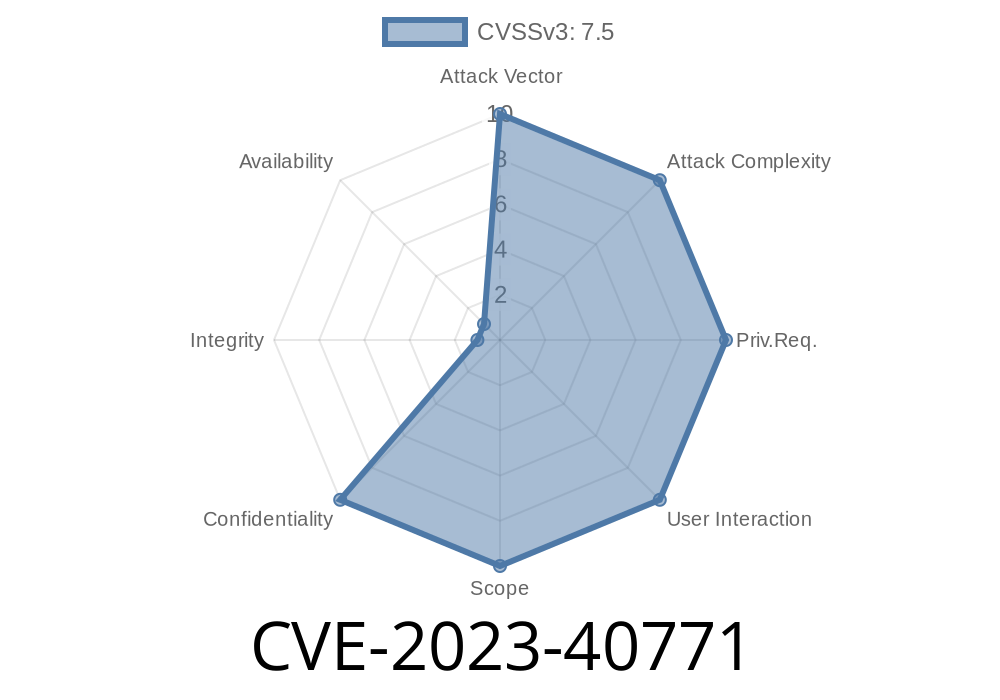A critical SQL injection vulnerability, CVE-2023-40771, has been discovered in DataEase v.1.18.9, a widely-used database management system known for its user-friendly and straightforward functionalities. This security flaw potentially allows a remote attacker to obtain sensitive information by exploiting the vulnerability outside of the system's blacklist function. This article will outline the details of this vulnerability, along with a code snippet illustrating how the attack may unfold. Additionally, we will provide links to original references and explore the steps users can take to protect their systems against this exploit.
Exploit Details
The SQL Injection vulnerability in DataEase v.1.18.9 arises due to an insufficient input validation within the framework. An attacker can craft a malicious string that can bypass the blacklist filter, enabling them to execute arbitrary SQL statements and obtain unauthorized access to sensitive information in the database.
Code Snippet
The following code snippet demonstrates how an attacker might exploit the CVE-2023-40771 vulnerability by crafting a malicious string that can bypass the built-in blacklist function:
-- Sample malicious SQL injection payload
1' OR 1=1;--
-- Hypothetical vulnerable DataEase code (in PHP)
$input_param = $_GET['input'];
$blacklist = array("'"," or ","=",";");
foreach($blacklist as $item) {
if(stripos($input_param, $item) !== false) {
die("Invalid input.");
}
}
$query = "SELECT * FROM users WHERE id = " . $input_param;
$result = mysqli_query($con, $query);
In this example, the payload ' OR 1=1;-- would circumvent the built-in blacklist filter, which is designed to detect and prevent malicious SQL injections. This would allow an attacker to execute arbitrary SQL statements and potentially gain unauthorized access to valuable data in the process.
More information on this vulnerability can be found in the sources referenced below
1. National Vulnerability Database (NVD) - CVE-2023-40771
2. Exploit Database - DataEase v.1.18.9 - SQL Injection
Mitigation Steps
Organizations and individuals using DataEase v.1.18.9 should take immediate steps to address this vulnerability to ensure the security of their systems. One effective approach to mitigate the risk posed by this vulnerability involves employing robust input validation and sanitization techniques. In addition, users should keep their systems updated with the latest security patches and follow established best practices for securing database installations.
For instance, some steps to protect against this vulnerability include
1. Employing parameterized queries and prepared statements, which can significantly reduce the likelihood of SQL injection attacks.
2. Implementing proper validation and sanitization of user inputs to minimize the potential for malicious payloads to end up in SQL statements.
3. Adopting the principle of least privilege for database accounts by restricting permissions and limiting the scope of actions that users can perform on the system.
Conclusion
The CVE-2023-40771 SQL injection vulnerability in DataEase v.1.18.9 is a serious security flaw that may allow a remote attacker to access sensitive information via a crafted string outside of the blacklist function. Organizations and individuals should take prompt action to safeguard their systems against this vulnerability by employing robust input validation and sanitization techniques, keeping systems up-to-date with security patches, and following established best practices for securing database installations.
Timeline
Published on: 09/01/2023 16:15:08 UTC
Last modified on: 09/06/2023 00:14:02 UTC
